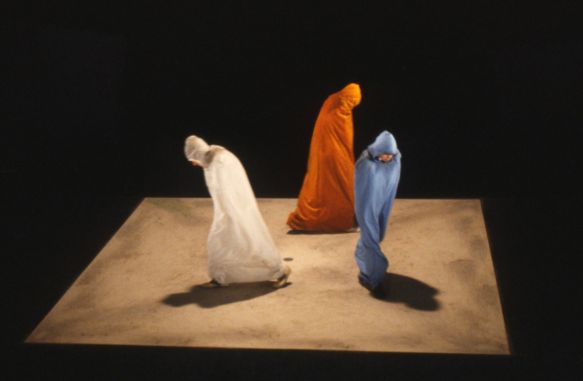
Quadrat I (FRG 1981, directed by Samuel Beckett)
Source: SWR
Experimental Television of the 1960s and ’70s
19.5. – 24.7.11
Exhibition
In the 1960s television developed worldwide into a dominant mass media, whose opinion-forming power was sceptically faced by artists and theorists. The “one-way communication,” which forces viewers into a passive role was criticized above all. As late as 1978, the former Federal Chancellor, Helmut Schmidt, called for a Sunday without television in order to free German television audiences from this passivity. Artists publicly took positions on the subject in radical art events. Wolf Vostell buried a television wound in barbed wire in New York (TV Burying, 1963) and staged a ritual shooting of a running television in Wuppertal (9-NEIN-de-coll/agen, 1963). Joseph Beuys covered a screen of a television set with felt (Filz-TV, 1966). Nam June Paik intervened in the electronics of the device itself and let viewers actively take part in the design of the image at the same time (Magnet TV, 1965; Participation TV, 1963).
Beginning in the mid-1960s, artists, writers, composers and directors started to deal with the medium of television and to search for a new visual language and narrative means. One of the most keenly experimental phases began for German television. An abundance of new aesthetic possibilities emerged with the introduction of magnetic recording, the bluebox process and chroma keying techniques that were used by many directors. A new aesthetic vision appeared in popular culture, in advertising and in television movies. Using exemplary works by individual artists, the exhibition shows a cross-section of this epoch of German television history.
Key aspects
Theater
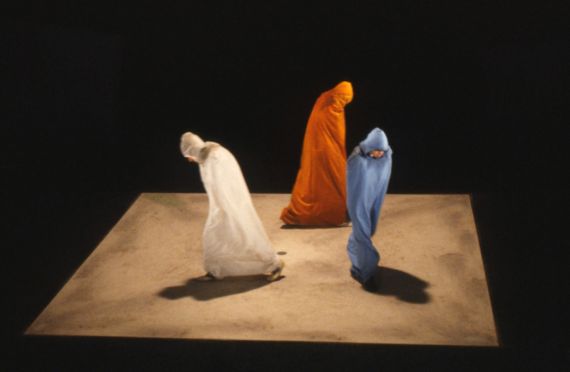
Quadrat I (FRG 1981, directed by Samuel Beckett)
Source: SWR
Samuel Beckett (1906–1989)
Beginning in 1965, Samuel Beckett turned to the medium of television to test new ways of expression. He wrote five film scripts for television from 1966–85 (Eh Joe [He Joe], Ghost Trio [Geistertrio], ... but the clouds ... [... nur noch Gewölk...], Quad I and II [Quadrat I, II], Night and Dreams [Nacht und Träume]) and adapted the television versions of two plays (Not I, Quoi où [a.k.a. What Where; Not I, Was wo]). He exactingly prepared his films; defining the camera work and lighting in every detail. Each take was precisely calculated, the gaps in conversation were measured with a stopwatch and the movements of the actors were meticulously laid out. Beckett’s television figures move like apparitions, with little text, in minimalistically arranged spaces that are gray and sparsely illuminated. The takes are normally long, and sound and picture are almost always separate. Quad I (1981), his only color film, functions completely without dialogue. Nearly all of Beckett’s television experiments in Germany were created for the Süddeutscher Rundfunk (SDR) broadcasting company.
Samuel Beckett is regarded as one of the most important writers of the 20th century. His best known work is the play “Waiting for Godot” (“En attendant Godot,” 1952). He was awarded the Nobel Prize in 1969.
Peter Zadek (1926–2009)
Peter Zadek was the only West German theater director who continuously worked in television and experimented with its aesthetic potential. He was particularly interested in electronic modification techniques, which he used for the first time in the television movie Der Kirschgarten (1966). In the films Rotmord (1969) and Der Pott (1971), he used chroma keying techniques and the bluescreen process for the first time. He had the Pop Art artist Guy Peellaert design the decorations and backgrounds in a studio mounted in blue with a bluepainted floor (bluebox), which consequently increased its alienating effect. Peter Zadek may be counted among the most influential theater and artistic directors in Germany. Among other achievements, he became known for his unconventional productions of Shakespeare’s plays.
Zadek produced 15 feature films for television and cinema.
Classical and New Music
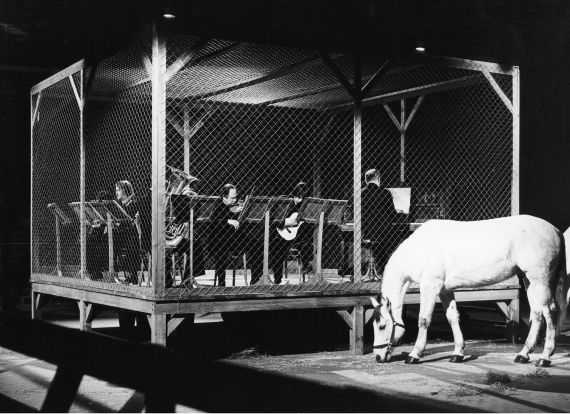
Kantrimiusik (FRG 1976, directed by Mauricio Kagel)
Mauricio Kagel (1931–2008)
The composer Mauricio Kagel belonged to the directors in German television, who were most eager to experiment. His associative, asynchronous, contrapuntal and humorous films testify to a know ledgeable and conscious manner of dealing with aesthetic means in the film medium. He worked with moving projections, played with size ratios and incorporated as music noises that were made by unusual sound generators. He confronted viewers again and again with their own expectations, which he jolted with Surreal poetry.
Mauricio Kagel cofounded the “Cinemathèque Argentine” in 1950, where he restored films from the Russian Revolution. Later, he became internationally famous as a composer, conductor, librettist, radio play author and film director. He realized more than 20 films for television.
Klaus Lindemann (1935–1993)
The director Klaus Lindemann brought classical and new music to television with much imagination. During his search for new aesthetic forms, he turned away from using music as bare illustration, moving the aesthetics of the images into the foreground instead. He experimented with focal shifts and long focal lengths, often mounting the images contrapuntally to the music. During his attempt to film Hans Werner Henze’s Tristan, a disagreement arose between the two of them, because the composer did not approve of Lindemann’s interpretation.
Klaus Lindemann shot numerous experimental musical films in the 1960s and early ’70s, including Kann man Verdi ernst nehmen? (1975) and Der Fall des Robert Schumann (1990).
Art
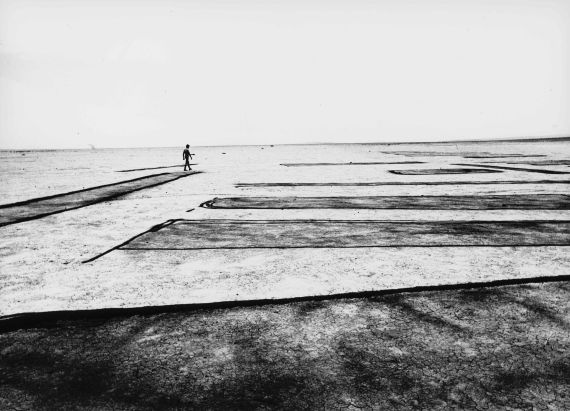
Land Art (FRG 1969, directed by Gerry Schum)
Gerry Schum (1938–1973)
Gerry Schum developed a new platform for the communication of art through “Fernsehgalerie I und II” (Television Gallery I and II). His 16mm films Land Art (1969) and Identifications (1970), shot exclusively for television, mostly without pan shots, cuts or comments – in which artists such as Richard Long, Barry Flanagan and Joseph Beuys participated – show the creative process of art. Schum held the opinion that art should no longer be the exclusive privilege of an elite, but should be accessible to all social levels. On account of the TV license fees that they are required to pay, Schum tended to regard television viewers as joint owners of films that are aired. However, the project failed after two broadcasts, because Gerry Schum’s aims could not be reconciled with the ideas of those who were responsible for the programs.
Gerry Schum studied at the Deutsches Institut für Film und Fernsehen (DIFF) in Munich and at the Deutsche Film- und Fernsehakademie Berlin (DFFB). He shot two films for the WDR, before he opened the Videogalerie Schum in Düsseldorf in 1971.
Black-and-White
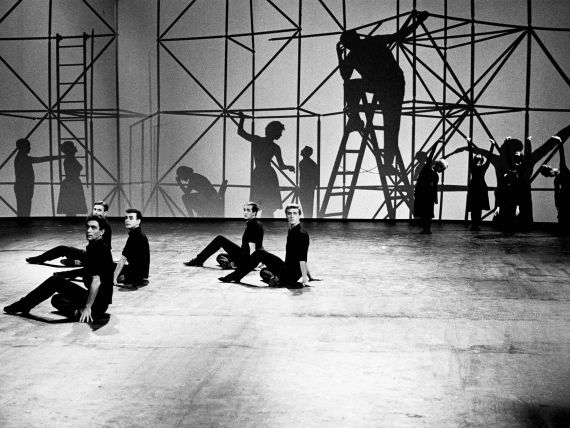
Portraits in Musik (FRG 1963)
Truck Branss (1926–2005)
At the beginning of the 1960s, the director Truck Branss was the first to allow pop song and chanson singers to appear on 30-minute music shows without any form of comment. He developed a completely new style of production: The stars wore markedly simple, monochrome clothing and performed against minimalistically designed studio backdrops. Long camera takes and a play with black-and-white effects were characteristic of Branss’ direction. Using low-key and high-key lighting known from photography, he developed a cinematographic style that was unusual for the mass medium and one that exhausted the aesthetic means of black-and-white television. Through his shows, he made Françoise Hardy known within Germany and helped Hildegard Knef to launch her singing career.
Truck Branss played a substantial part in building up television in Germany. In 1951, he was already working as a camera assistant during the first experimental TV programs of the SFB, before he became a director at the Saarländischer Rundfunk. In addition to numerous entertainment shows, he carried out several films on ballet and also about classical music.
Pop-Art
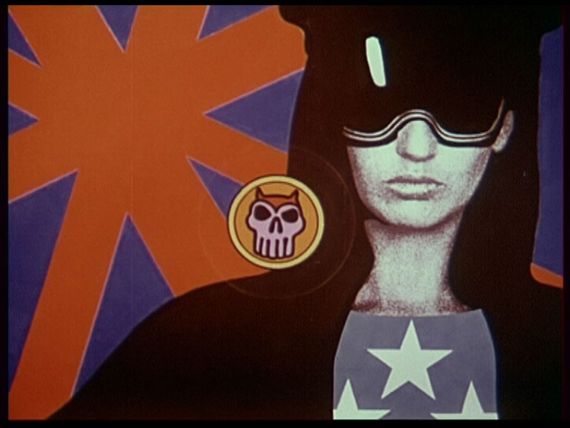
Idea (FRG/F 1968, directed by Jean-Christophe Averty)
Through the television show Idea (ZDF/RTB, 1968), the French director Jean Christophe Averty and the Belgian comic strip illustrator Guy Peellaert brought Pop Art to German television entertainment. Disassociating himself from traditional television direction, which he criticized as mere adaptation of film and theater, Averty developed his own aesthetic, in which graphic elements are predominant and the three-dimensionality of the space shown is apparently dissolved. The Dutch director Bob Rooyens brought the spectacular Dusty Springfield show to television a year later. In the studios of the WDR, he experimented with all the technical possibilities that were available to him. Michael Leckebusch, who realized the legendary Beat-Club (RB), experimented primarily with bluebox and chroma keying techniques. The director Pierre Koralnik, who, among other things, staged a controversial show with Vicky Leandros, worked with color collages and electronic chroma key effects on images of the Vietnam War and various political events of the times.
Commercial
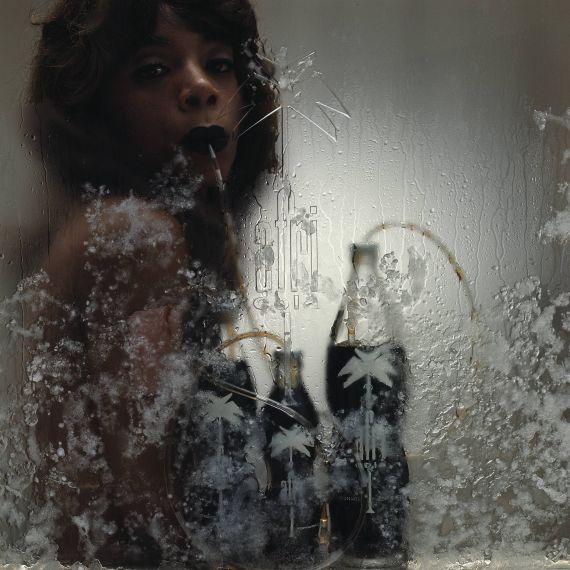
Afri-Cola Commercial (FRG 1968, directed by Charles Wilp)
Charles Wilp (1932–2005)
“Super-sexy-mini-flower-pop-op-cola – alles ist in Afri-Cola” (… Everything is in Afri-Cola) – Charles Wilp started an unusual ad campaign in 1968 with this slogan. In his commercials, he combined the themes of Pop Art and sexual liberation with psychedelic fantasies, thereby hitting on the attitudes towards life held by the generation of ’68. Behind frozen surfaces, he positioned models dressed as nuns, people of color and women from all social classes. He was able to gain the commitment of renowned celebrities such as Donna Summer, Amanda Lear and Marianne Faithfull for this.
Charles Wilp – artist, photographer and advertising man – was a student of the photographer Man Ray and of the designer Raymond Loewy in New York. He accepted responsibility for numerous advertising campaigns, including the Pushkin vodka brand and Pirelli tires; for the VW beetle he came up with the well-known slogan “Er läuft und läuft und läuft …” (It goes and goes and goes…).
Humanic
The Austrian shoe company Humanic developed one of the most successful advertising campaigns of the last decades with their television commercials. What made this art campaign so special was that the participating artists – directors, sculptors, painters, composers, photographers, singers and authors – were completely free in the design of their commercials. Texts by contemporary Austrian writers, including Wolfgang Bauer, H. C. Artmann and Andreas Okopenko, were used in individual advertisements.
Extraterrestrials
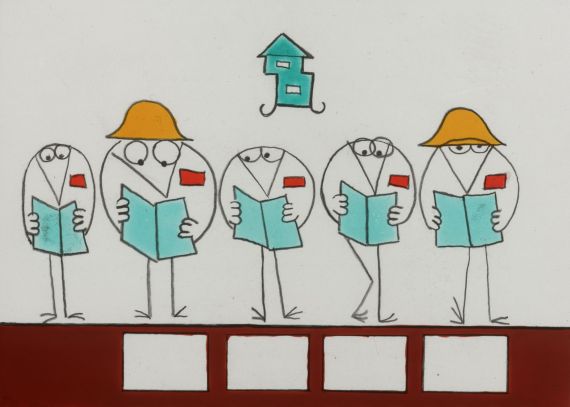
Les Shadoks (F 1968-1973, directed by Jacques Rouxel)
Jacques Rouxel (1931–2004)
Ga Bu Zo Meu – This language of the Shadoks, which is comprised of only four syllables that have command over four brain cells (among beings who have their children by counting to four), is part of a fantastic model for society invented by the French cartoonist and author Jacques Rouxel. The ironic, minimalist portrayal of his figures caused passionate reactions among viewers: More than half a million letters were received by the French television station ORTF (Office de Radio Télédiffusion Française) during the period of its daily broadcast. While one half of the viewers understood the series as intelligent and highly-complex social criticism, the other half was indignant to be served an abstruse animated series during prime time. A year after its debut, the first season was shown to the so-called “Nordschiene” on the German ARD station at 8:15 p.m.
Jacques Rouxel began working with the French television network ORTF in the research department in 1965. In addition to his series classic Les Shadoks (159 episodes in three seasons), he realized more than 80 promotional and educational films. Rouxel published several books and was a cofounder of the aaa animation studio in Paris in 1973.
Gallery
Information and Credits
Credits
Curator: Gerlinde Waz
Exhibition Coordination / Curatorial Assistance: Antje Materna
Media Programme: Gerlinde Waz
Licences: Antje Materna
Exhibits: Gerlinde Waz, Antje Materna
Project Management: Peter Mänz
Assistants: Vera Thomas, Melanie Martin
Interns: Lill Sommer, Lydia Oswald
Exhibition Design: Ingrid Jebram, Jebram-Szenographie
Exhibition Construction: Camillo Kuschel
Exhibition Graphics Design: Felder KölnBerlin
Advertising Graphics Design: Pentagram Design, Berlin
Conservational Supervision: Sabina Fernández
Scans: Peter Latta
AV-Media Editing: Anette Fleming, Concept AV, Berlin
Media Processing: Oliver Hanley
Technical Services: Stephan Werner, Roberti Siefert, Frank Köppke
Press and Public Relations: Katrin Kahlefeld, Sandra Hollmann, Heidi Berit Zapke
The Exhibition is sponsored by
SHAPE \* MERGEFORMAT
in accordance with a decision of the German Bundestag
Acknowledgements
Matthew Arnatt
Guy Baxter, University of Reading
Jana Behrendt, SWR
Dr. Eugen Blume, Hamburger Bahnhof
Andreas Boldt
Roma Branss
Maximilian Britzger
Sylvie Dargnies, INA
Thierry Dejean
Ursula Ehler-Dorst
Tankred Dorst
Dr. Fritz Emslander, Museum Morsbroich
Helfrid Foron
Roland Freyberger
Rasmus Gerlach
Roswitha Hecke
Karin Herbst-Meßlinger
Dr. Kay Hoffmann, Haus des Dokumentarfilms
Dr. Jörg Hucklenbroich, SWR
Henriette Huldisch, Hamburger Bahnhof
Matthias Kassel, Paul Sacher Stiftung
Reinhard Krämer
Dr. Michael Lailach, Kunstbibliothek
Matthieu Lamotte, aaa production
Maria Lutze, WDR
Claudia Maugg, rbb
Dr. Torsten Musial, Akademie der Künste
Michèle Noirjean-Linder, Paul Sacher Stiftung
Dr. Mark Nixon, University of Reading
Elisabeth Peellaert
Elisabeth Plessen
Prof. Harald Reichelt
Bettina Reiss, SWR
Sylvie Richard, INA
Andrea Rieder
Günther Rohrbach
Jörg Sonntag, Radio Bremen
Carola Veit
Dorothea Wesseler
Birgit Wieneritsch, WDR
Daniel Willinger, Leder & Schuh
International AG
Petra Witting-Nöthen, WDR
alle Kolleginnen und Kollegen der Deutschen Kinemathek – Museum für Film und Fernsehen
Lenders
Matthew Arnatt, London
BR, München
Bayerische Staatsbibliothek München
bpk – Bildagentur für Kunst, Kultur und Geschichte, Berlin
Tankred Dorst, Berlin/München
Electronic Arts Intermix (EAI), New York
Roland Freyberger, Köln
Rasmus Gerlach, Hamburg
Roswitha Hecke, Hamburg
Humanic, Graz
Institut national de l’audiovisuel (Ina), Paris
Matthieu Lamotte, aaa production, Paris
Museo Vostell Malpartida, Cáceres
NDR, Hamburg
Paul Sacher Stiftung, Basel
Elisabeth Peellaert, Paris
Privatarchiv Peter Zadek, Elisabeth Plessen, Berlin/Vecoli
Privatarchiv Truck Branss, Andreas Boldt, Bad Camberg
Radio Art, Berlin
RB, Bremen
rbb, Berlin/Babelsberg
rbb, Pressearchiv
Günther Rohrbach, München
SR, Saarbrücken
Staatliche Museen zu Berlin, Kunstbibliothek
Staatliche Museen zu Berlin, Kunstbibliothek, Sammlung Marzona
SWR, Stuttgart
SWR, Historisches Archiv Baden-Baden
SWR, Historisches Archiv Stuttgart
University of Reading, Beckett Collection
Dorothea Wesseler, Köln
WDR, Köln
WDR, Historisches Archiv, Köln
Lenders
Matthew Arnatt, London
BR, München
Bayerische Staatsbibliothek München
bpk – Bildagentur für Kunst, Kultur und Geschichte, Berlin
Tankred Dorst, Berlin/München
Electronic Arts Intermix (EAI), New York
Roland Freyberger, Köln
Rasmus Gerlach, Hamburg
Roswitha Hecke, Hamburg
Humanic, Graz
Institut national de l’audiovisuel (Ina), Paris
Matthieu Lamotte, aaa production, Paris
Museo Vostell Malpartida, Cáceres
NDR, Hamburg
Paul Sacher Stiftung, Basel
Elisabeth Peellaert, Paris
Privatarchiv Peter Zadek, Elisabeth Plessen, Berlin/Vecoli
Privatarchiv Truck Branss, Andreas Boldt, Bad Camberg
Radio Art, Berlin
RB, Bremen
rbb, Berlin/Babelsberg
rbb, Pressearchiv
Günther Rohrbach, München
SR, Saarbrücken
Staatliche Museen zu Berlin, Kunstbibliothek
Staatliche Museen zu Berlin, Kunstbibliothek, Sammlung Marzona
SWR, Stuttgart
SWR, Historisches Archiv Baden-Baden
SWR, Historisches Archiv Stuttgart
University of Reading, Beckett Collection
Dorothea Wesseler, Köln
WDR, Köln
WDR, Historisches Archiv, Köln
Acknowledgements
Thanks to
Matthew Arnatt
Guy Baxter, University of Reading
Jana Behrendt, SWR
Dr. Eugen Blume, Hamburger Bahnhof
Andreas Boldt
Roma Branss
Maximilian Britzger
Sylvie Dargnies, INA
Thierry Dejean
Ursula Ehler-Dorst
Tankred Dorst
Dr. Fritz Emslander, Museum Morsbroich
Helfrid Foron
Roland Freyberger
Rasmus Gerlach
Roswitha Hecke
Karin Herbst-Meßlinger
Dr. Kay Hoffmann, Haus des Dokumentarfilms
Dr. Jörg Hucklenbroich, SWR
Henriette Huldisch, Hamburger Bahnhof
Matthias Kassel, Paul Sacher Stiftung
Reinhard Krämer
Dr. Michael Lailach, Kunstbibliothek
Matthieu Lamotte, aaa production
Maria Lutze, WDR
Claudia Maugg, rbb
Dr. Torsten Musial, Akademie der Künste
Michèle Noirjean-Linder, Paul Sacher Stiftung
Dr. Mark Nixon, University of Reading
Elisabeth Peellaert
Elisabeth Plessen
Prof. Harald Reichelt
Bettina Reiss, SWR
Sylvie Richard, INA
Andrea Rieder
Günther Rohrbach
Jörg Sonntag, Radio Bremen
Carola Veit
Dorothea Wesseler
Birgit Wieneritsch, WDR
Daniel Willinger, Leder & Schuh
International AG
Petra Witting-Nöthen, WDR
all colleagues at Deutsche Kinemathek – Museum für Film und Fernsehen
Partners
This exhibition is sponsored by
Der Beauftragte der Bundesregierung für Kultur und Medien
in accordance with a decision of the German Bundestag
Supported by
Friedrich-Wilhelm-Murnau-Stiftung
OSRAM
Dussmann das KulturKaufhaus
Yorck Kinogruppe
ARD
ZDF
RTL
SAT.1
Media partners
taz. die tageszeitung
In collaboration with
Veolia Wasser
Ina
ZDF
RTL
ARD
SWR
WDR
SR
Radiobremen
Rbb Fernsehen
BR
NDR




